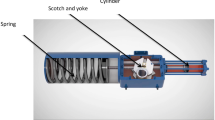Abstract
Seat tightness at the fully shut position should be a consideration in the development of a butterfly valve for use in a liquefied natural gas (LNG) vessel. A flexible solid metal seal offers sufficient tightness of the butterfly valve and meets the specifications for cryogenic temperature. In the present study, characteristics for a cryogenic butterfly valve, such as the flow coefficient and the pressure loss coefficient, were estimated by numerical fluid analysis carried out to simulate 3-D flow and to study performance as it was affected by the opening angles of the valve disc. A design criterion to ensure the seat tightness of the butterfly valve at the fully shut position was proposed, in which the contact pressure between the metal seal and the valve disc would be compared with the fluid pressure. Numerical structural analysis showed that the contact pressure can be calculated by simulation of the frictional contact behavior on the surface of the metal seal and the valve disc. As a result, an adequate flexibility of the metal seal and the valve disc was required in order to accomplish a contact pressure that would be high enough to satisfy the seat tightness requirement. Under cryogenic temperature, thermal shrinkage caused the metal seal to adhere closely to the valve disc periphery at both sides and raised the contact pressure to a relatively high value, though there was no contact across a small area at the center position, which is susceptible to leakage. An additional displacement of the metal seal and the valve disc appeared at an operating fluid pressure of 6.9 bar and produced sufficient contact pressure at the no-contact area. This was verified by experimental leakage tests performed at room and cryogenic temperatures.
Similar content being viewed by others
Reference
Y. J. Ahn, B. J. Kim and B. R. Shin, Numerical analysis of 3-D Flow through LNG marine control valves for their advanced design, Journal of Mechanical Science and Technology, 22 (2008) 1998–2005.
D. K. Kim and J. H. Kim, A study on structure analysis of glove valve for LNG carrier, Journal of the Korean Society of Marine Engineering, 31(8) (2007) 1013–1019.
X. G. Song, L. Wang, S. H. Baek and Y. C. Park, Multidisciplinary optimization of a butterfly valve, ISA Transaction, 48 (2009) 370–377.
T. Kimura, T. Tanaka, K. Fujimoto and K. Ogawa, Hydrodynamic characteristics of a butterfly valve-prediction of pressure loss characteristics, ISA Transaction, 34 (1995) 319–326.
Feature butterfly valves, new developments in triple-offset butterfly valves, World Pumps (September 2004) 40–44.
Cryogenic metal seated butterfly valves, www. velan.com.
Valves all along the LNG chain, www.ksb.fr.
BFGoodrich, Metal C-Rings, www.garlock.net.
E-Seals, JE/JH Series, www.jetseal.com.
BS6755, Testing of valves — Part 1: Specification production pressure testing requirements, British Standard Institution (1986).
BS6364, Specification for valve for cryogenic service, British Standard Institution (1984).
P. L. Skousen, Valve handbook — 2nd Edition, McGraw-Hill, USA. (2006).
S. W. Kim, Y. D. Choi, B. S. Kim and Y. H. Lee, Flow characteristics of cryogenic butterfly valve for LNG carrier (Part 2: Flow characteristics under cryogenic condition), Journal of KFMA, 11(2) (2008) 20–28.
L. Wang, X. G. Song and Y. C. Park, Dynamic analysis of fluid flow passing a large butterfly valve, 3rd global conference on PCO, Gold Coast, Australia (2–4 Feb. 2010).
S. M. Lee, S. X. Quan, J. H. Kang and Y. C. Park, Analysis of butterfly valve’s metal seat using F.E.M, KSMPE Spring Conference, Jeju, Korea (2008) 167–169.
R. D. Villepoix, M. Lefrancois, J. Montucard and C. Rouaud, Latest development on valve seat-seal assembly, Fusion Engineering and Design, 29 (1995) 358–362.
ANSYS Workbench — Simulation Introduction, Release 12.0 (2009), www.ansys.com.
J. K. Kim, Application of LNG to complex power generation system (internal report), Kumho Engineering Co. (1999) 1–17.
Author information
Authors and Affiliations
Corresponding author
Additional information
This paper was recommended for publication in revised form by Associate Editor Seong Beom Lee
Jun Tae Ahn received his B.S degree in Mechanical Engineering from Donga University, Korea, in 2010. He is currently an M.S. student at the Department of Mechanical Engineering of the same university. His research interests include machine elements design, fatigue life design and FSI-analysis.
Seung Ho Han received his B.S. and M.S. degrees in Mechanical Engineering from Hanyang University, Korea, in 1989 and 1991, respectively. He then received his Doctor degree from RWTH Aachen, Germany, in 1996. Dr. Han is currently a Professor at the Department of Mechanical Engineering of Dong-A University in Busan, Korea. Dr. Han’s research interests include reliability based design and fatigue life extension technique.
Rights and permissions
About this article
Cite this article
Ahn, J.T., Lee, K.C., Lee, K.H. et al. Investigation of the mechanical behavior of a flexible solid metal seal for a cryogenic butterfly valve. J Mech Sci Technol 25, 2393–2400 (2011). https://doi.org/10.1007/s12206-011-0534-5
Received:
Revised:
Accepted:
Published:
Issue Date:
DOI: https://doi.org/10.1007/s12206-011-0534-5




